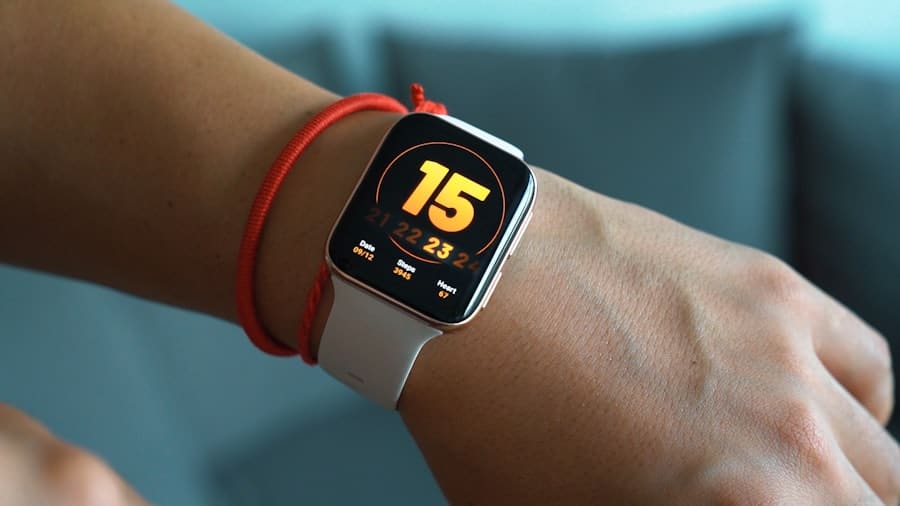In recent years, the advent of wearable technology has revolutionized the way individuals monitor their health and fitness. Among these innovations, smart bands have emerged as a popular tool for tracking various physiological metrics. These devices, often worn on the wrist, are equipped with sensors that can measure heart rate, sleep patterns, physical activity, and even stress levels.
The integration of advanced algorithms allows smart bands to provide users with insights into their overall well-being, making them invaluable for both casual fitness enthusiasts and elite athletes alike. Smart bands are not merely fitness trackers; they represent a convergence of technology and health science. With the ability to sync data to smartphones and other devices, users can access real-time analytics and historical trends regarding their physical performance.
This capability is particularly beneficial for athletes who require precise data to optimize their training regimens. As the demand for performance enhancement grows, so does the reliance on smart bands to provide actionable insights that can lead to improved athletic performance and recovery.
Key Takeaways
- Smart bands are wearable devices that can track various aspects of an individual’s health and fitness, including recovery.
- Recovery is crucial for elite athletes as it allows the body to repair and adapt to the stress of training, ultimately improving performance and reducing the risk of injury.
- Smart bands track recovery by monitoring metrics such as heart rate variability, sleep quality, and activity levels to provide insights into an athlete’s readiness to train or compete.
- Using smart bands for recovery monitoring can help elite athletes optimize their training, prevent overtraining, and make more informed decisions about their performance and recovery strategies.
- Case studies of elite athletes using smart bands have shown improvements in performance, injury prevention, and overall well-being, highlighting the potential benefits of incorporating these devices into recovery monitoring routines.
The Importance of Recovery for Elite Athletes
For elite athletes, the pursuit of excellence is not solely about rigorous training; it also hinges on effective recovery strategies. Recovery is a critical component of any training program, as it allows the body to repair itself after intense physical exertion. During recovery, muscles rebuild, energy stores are replenished, and the risk of injury diminishes.
Athletes who neglect recovery may experience diminished performance, increased fatigue, and a higher likelihood of injuries, which can derail their competitive aspirations. The physiological processes involved in recovery are complex and multifaceted. For instance, during sleep, the body undergoes various restorative processes, including muscle repair and hormonal regulation.
Additionally, active recovery techniques such as stretching, foam rolling, and low-intensity exercise can enhance blood flow to muscles, facilitating nutrient delivery and waste removal. Understanding these processes is essential for athletes who aim to maximize their performance while minimizing downtime due to injury or fatigue.
How Smart Bands Track Recovery

Smart bands utilize a variety of sensors and technologies to monitor recovery metrics effectively. One of the primary metrics tracked is heart rate variability (HRV), which measures the variation in time between heartbeats. A higher HRV is often indicative of a well-recovered athlete, while a lower HRV may suggest fatigue or overtraining.
By continuously monitoring HRV, smart bands can provide athletes with insights into their recovery status and readiness for subsequent training sessions. In addition to HRV, smart bands also track sleep quality and duration, which are crucial for recovery. Many devices employ accelerometers to detect movement during sleep, allowing them to differentiate between light sleep, deep sleep, and REM sleep stages.
This data can help athletes understand how well they are recovering overnight and whether they need to adjust their training intensity or duration based on their sleep patterns. Furthermore, some smart bands incorporate stress monitoring features that assess physiological responses to stressors, providing a holistic view of an athlete’s recovery state.
Benefits of Using Smart Bands for Recovery Monitoring
The benefits of using smart bands for recovery monitoring extend beyond mere data collection; they empower athletes with actionable insights that can enhance their training regimens. One significant advantage is the ability to personalize recovery strategies based on real-time data. For example, if an athlete’s HRV indicates insufficient recovery, they can adjust their training plan by incorporating more rest days or lighter workouts.
This level of customization helps prevent overtraining and optimizes performance. Moreover, smart bands facilitate accountability and motivation. Many athletes find that having quantifiable metrics encourages them to adhere to their recovery protocols more diligently.
The gamification aspect of tracking progress—such as achieving daily step goals or improving sleep quality—can foster a sense of accomplishment that motivates athletes to prioritize recovery as much as training itself. This shift in mindset can lead to long-term improvements in both physical performance and overall well-being.
Case Studies of Elite Athletes Using Smart Bands
Numerous elite athletes have embraced smart bands as part of their training and recovery routines, showcasing the effectiveness of these devices in real-world scenarios. For instance, professional basketball player LeBron James has been known to utilize wearable technology to monitor his physical condition closely. By analyzing data from his smart band, he can make informed decisions about his training load and recovery needs throughout the grueling NBA season.
Similarly, Olympic swimmer Michael Phelps has publicly endorsed the use of wearable technology for performance enhancement. Phelps has utilized smart bands to track his sleep patterns and recovery metrics during training camps leading up to competitions. By understanding how his body responds to different training intensities and recovery strategies, he has been able to fine-tune his approach to maximize his performance in the pool.
Limitations and Challenges of Smart Bands for Recovery Monitoring

Despite their numerous advantages, smart bands are not without limitations and challenges when it comes to recovery monitoring. One significant concern is the accuracy of the data collected by these devices. While many smart bands employ advanced sensors, factors such as skin tone, body composition, and even environmental conditions can affect readings like heart rate and HRV.
Consequently, athletes must be cautious when interpreting data and should consider using smart bands as part of a broader suite of monitoring tools rather than relying solely on them. Another challenge lies in the potential for information overload. With a plethora of metrics available at an athlete’s fingertips, it can be overwhelming to discern which data points are most relevant for optimizing recovery.
Athletes may find themselves fixated on specific numbers rather than focusing on holistic well-being. To mitigate this issue, it is essential for athletes to work with coaches or sports scientists who can help interpret data meaningfully and integrate it into their overall training strategy.
Future Developments in Smart Bands for Recovery Monitoring
The future of smart bands in recovery monitoring is promising, with ongoing advancements in technology poised to enhance their capabilities further. One area of development is the integration of artificial intelligence (AI) algorithms that can analyze vast amounts of data from multiple sources—such as nutrition intake, training loads, and biometric readings—to provide personalized recommendations for recovery strategies. This level of sophistication could revolutionize how athletes approach their training regimens by offering tailored insights that adapt in real-time.
For instance, emerging technologies such as optical sensors could improve heart rate monitoring accuracy while minimizing interference from external factors. Furthermore, the incorporation of non-invasive blood glucose monitoring could provide athletes with insights into their metabolic state during recovery periods, allowing for more informed nutritional decisions.
Conclusion and Recommendations for Elite Athletes
As elite athletes continue to seek ways to enhance their performance while minimizing injury risk, smart bands have emerged as valuable tools for monitoring recovery. By providing real-time data on key metrics such as heart rate variability and sleep quality, these devices empower athletes to make informed decisions about their training regimens. However, it is crucial for athletes to approach this technology with a balanced perspective—recognizing both its potential benefits and limitations.
To maximize the effectiveness of smart bands in recovery monitoring, athletes should consider integrating these devices into a comprehensive approach that includes collaboration with coaches and sports scientists. By interpreting data within the context of individual training goals and overall well-being, athletes can harness the full potential of smart bands while ensuring they remain focused on their long-term performance objectives. As technology continues to evolve, the future holds exciting possibilities for enhancing athletic performance through innovative recovery monitoring solutions.
In the realm of sports technology, understanding how smart bands monitor recovery for elite athletes is crucial for optimizing performance. For those interested in enhancing their training experience, you might also find value in exploring the best headphones of 2023, which can provide an immersive audio experience during workouts, helping athletes stay motivated and focused on their recovery and training goals.
FAQs
What are smart bands?
Smart bands are wearable devices that are equipped with sensors to track various aspects of a person’s health and fitness, such as heart rate, sleep patterns, and physical activity.
How do smart bands monitor recovery for elite athletes?
Smart bands monitor recovery for elite athletes by tracking their heart rate variability, sleep quality, and overall physical activity levels. This data is then used to assess an athlete’s readiness to train or compete at their peak performance level.
What is heart rate variability (HRV) and why is it important for athletes?
Heart rate variability (HRV) is the variation in time intervals between heartbeats. It is an important indicator of an athlete’s recovery and readiness to perform, as it reflects the balance between the sympathetic and parasympathetic nervous systems.
How do smart bands measure sleep quality?
Smart bands measure sleep quality by tracking the duration and depth of sleep, as well as the presence of interruptions or disturbances during the night. This data is used to assess an athlete’s recovery and overall well-being.
What are the benefits of using smart bands to monitor recovery for elite athletes?
The benefits of using smart bands to monitor recovery for elite athletes include the ability to track and analyze key physiological markers, optimize training and recovery strategies, and ultimately improve performance while reducing the risk of overtraining and injury.

